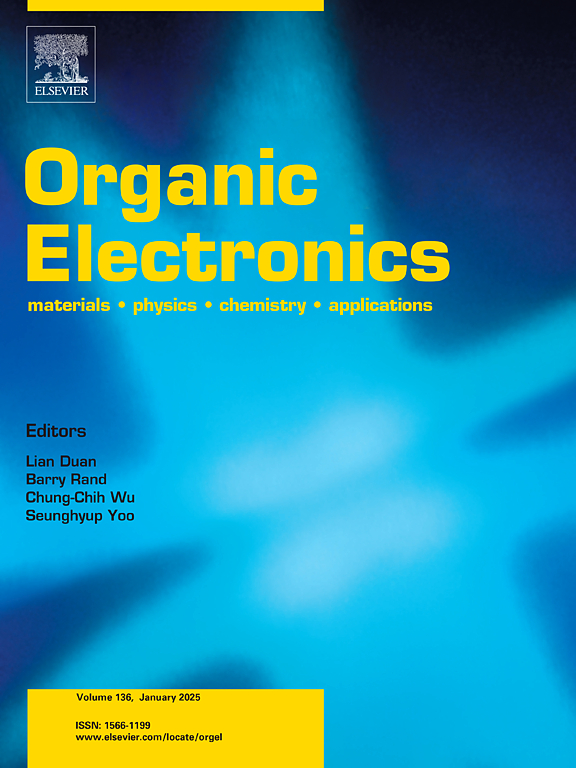Highly efficient orange and white organic light-emitting diodes with low efficiency roll-off based on a novel exciplex host
IF 2.6
4区 工程技术
Q3 MATERIALS SCIENCE, MULTIDISCIPLINARY
引用次数: 0
Abstract
Realizing highly efficient organic light-emitting diodes (OLEDs) with low efficiency roll-off through exciplex systems remains challenging due to mismatched transport property between donor and acceptor. Herein, a novel exciplex co-host system constructed by 1,1-Bis[(di-4-tolylamino) phenyl] cyclohexane (TAPC) and 2,4-diphenyl-6-(9,9′-spirobi[9H-fluoren]-3-yl)-1,3,5-Triazine (SF3-TRZ) is applied to design simplified orange and white OLEDs with high efficiency and low efficiency roll-offs. The result orange phosphorescent OLED is realized by doping orange dopant into exciplex host, demonstrating outstanding characteristics with a maximum current efficiency of 81.3 cd/A and a maximum power efficiency of 84.7 lm/W. By further inserting a blue emitting layer, the white OLED with stable spectra achieves a current efficiency of 62.1 cd/A with an extremely low roll-off, which represents one of the smallest values reported for exciplex co-host white OLEDs. The superior performance of the device is attributed to the balanced carriers transport and the simplified architecture design. The architecture provides a promising solution for developing high-performance OLEDs toward practical solid-state lighting applications.

基于新型激复体的低滚转高效橙白有机发光二极管
由于供体和受体之间输运性质不匹配,实现低效率滚转的高效有机发光二极管(oled)仍然具有挑战性。本文采用1,1-二[(二-4-甲苯胺)苯基]环己烷(TAPC)和2,4-二苯基-6-(9,9 ' -spirobi[9h -芴]-3-yl)-1,3,5-三嗪(SF3-TRZ)构建了一种新型外络合物共宿主体系,用于设计具有高效率和低效率roll- out的简化橙色和白色oled。结果表明,将橙色掺杂剂掺杂到异型主体中实现了橙色磷光OLED,其最大电流效率为81.3 cd/ a,最大功率效率为84.7 lm/W。通过进一步插入蓝色发射层,具有稳定光谱的白色OLED实现了62.1 cd/ a的电流效率,并且具有极低的滚降,这是迄今为止报道的单一共主白色OLED的最小值之一。该装置的优越性能归功于平衡的载流子传输和简化的结构设计。该架构为开发面向实际固态照明应用的高性能oled提供了一个有前途的解决方案。
本文章由计算机程序翻译,如有差异,请以英文原文为准。
求助全文
约1分钟内获得全文
求助全文
来源期刊

Organic Electronics
工程技术-材料科学:综合
CiteScore
6.60
自引率
6.20%
发文量
238
审稿时长
44 days
期刊介绍:
Organic Electronics is a journal whose primary interdisciplinary focus is on materials and phenomena related to organic devices such as light emitting diodes, thin film transistors, photovoltaic cells, sensors, memories, etc.
Papers suitable for publication in this journal cover such topics as photoconductive and electronic properties of organic materials, thin film structures and characterization in the context of organic devices, charge and exciton transport, organic electronic and optoelectronic devices.
 求助内容:
求助内容: 应助结果提醒方式:
应助结果提醒方式:


